Day 1 of a 4-day Autumn Migration tour. After a cloudy start, it brightened up late morning and was bright and sunny in the afternoon.
Our destination for the morning was Holkham. As we got out of the minibus at Lady Anne’s Drive, several Jays flew back and forth out of the pines. They would be a feature of the whole day, and indeed the whole tour ( the first ‘Jay of the Day’ being noted daily!). In the autumn, Jays disperse in search of acorns. In years of poor acorn production they may move considerable distances in search of food and become very visible across the wider countryside. 2024 does not look like a particularly good year for acorns, so there may be some wider dispersal happening this year.

There were small flocks of Starlings on the move too this morning, but there didn’t see to be too many thrushes. Two Redwings did fly over and landed briefly in one of the trees by the drive. A small group of Pink-footed Geese came up off the grass. We had a closer look through them – there had been a couple of Snow Geese with the Pinkfeet here briefly yesterday morning, but they seemed to have disappeared. We hoped we might come across them again.
As we set off walking west on the track before the pines, a flock of Lapwings came over the trees. Small flocks of finches flew overhead too – mostly Chaffinches, and at least one group of Siskins. There were definitely migrants on the move today, coming in off the sea from Scandinavia and then heading west along the coast.
The trees were quiet at first, no sign of any tit flocks. A single Treecreeper appeared on a trunk by the track, but it was on its own, nothing with it.
We stopped for a quick look at Salts Hole – there were lots of Gadwall out on the water, most of the drakes back mostly in smart breeding plumage already, and a few Wigeon where the drakes were still largely in eclipse, a bit behind in moulting. Several Little Grebes were diving round the edges of the reeds.

As we walked on, looking over the reeds we could see a few Cattle Egrets with the cattle out on the grazing marsh. We stopped to scan from the gate before Washington Hide and could still just see them more distantly. A Kestrel was perched in the top of a large hawthorn and a Cetti’s Warbler shouted from the reeds.
The boardwalk by Washington Hide is closed for repairs so we couldn’t go up to check the trees (the wardens drove up with some new timbers while we were standing there, so hopefully it won’t be closed for long). We could hear tits in the pines just before the boardwalk, so we stopped and watched. Several birds flew out into the sycamores, Long-tailed Tits, Blue Tits, Great Tits and Coal Tits, plus a couple of Goldcrests. We couldn’t find anything rarer with them though.
More birds flew down into the smaller trees by the track, and some came down to bathe in the puddles. A Goldcrest landed on the track too and started flycatching, trying to snatch at the flies which were swarming around just above the ground. We could hear a Great Spotted Woodpecker calling up in the trees and a Water Rail squealing in the reeds.
As we continued west, we found another tit flock just before the crosstracks. There were a couple of Chiffchaffs with these ones. They were moving through the trees quickly but then we found a Firecrest with the Goldcrests, which we managed to follow for a while before it disappeared back into the pines.
A Yellow-browed Warbler appeared briefly in the large sallow clump, where we could see it flitting around in the leaves. When it flew back into the trees, we could hear another Yellow-browed Warbler calling in the sycamores ahead of us. It then flew in to the large sallow clump beside us too, but didn’t stay long and quickly followed the rest of the flock into the trees.
We took the path in to the pines from the crosstracks and quickly located the flock up in the tops of the deciduous trees. There were plenty of tits and Goldcrests here now but they were moving quickly up into the pines. We heard a Yellow-browed Warbler call behind us. Rather than try to follow the flock up in the pines, we decided to continue on through the pines to the beach.
Scanning the sea from the top of the dunes, we could see large rafts of Common Scoter gathered offshore. There were a few Great Crested Grebes in with them and one or two Red-throated Divers offshore too, pale winter adults.
A juvenile Gannet flew east over the sea, followed by another two west further out. Two drake Eider then flew past, as did a small flock of Knot. There was a smaller, darker wader with them but unfortunately it was too distant to make out. Three Sanderling flew east along the beach, and then back west shortly after.
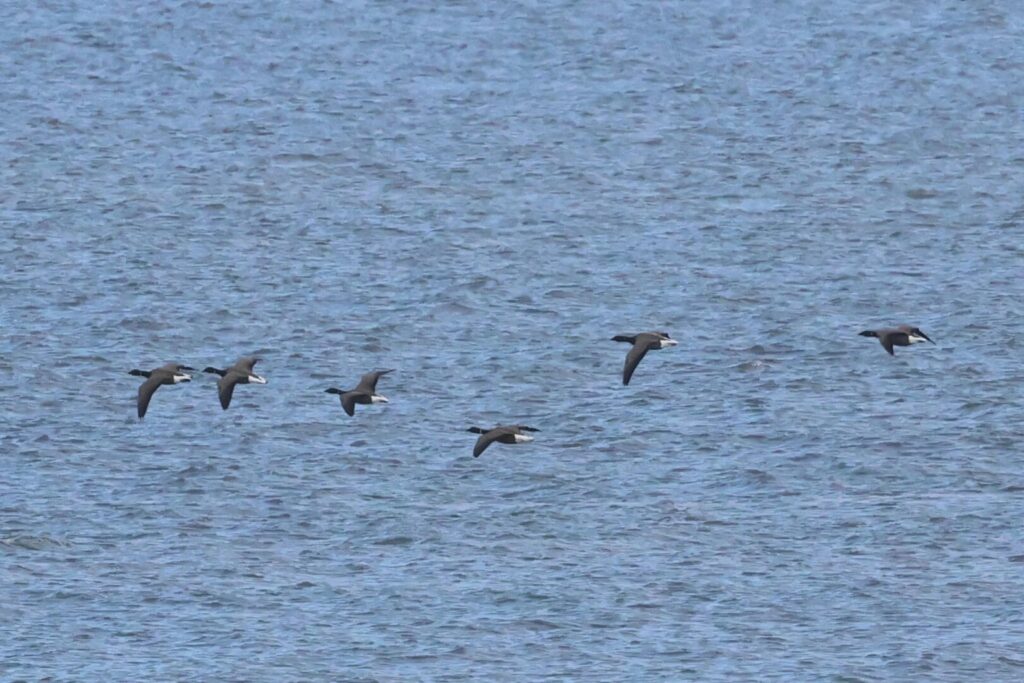
A few Skylarks came in over the beach, fresh arrivals from the continent, and some small groups of Wigeon and Teal were moving offshore. There were some Brent Geese coming in too this morning, and a small group of Shelduck flew past over the sea. Nice to see autumn migration in action!
Back through the dunes, we could hear a Green Woodpecker calling and just caught a glimpse of it as it flew off up into the pines. A couple of Stonechats were perched on the bushes.
The other side of the crosstracks, we called in at the new Joe Jordan Hide. A Great White Egret was stalking one of the pools along with a nearby Little Egret for size comparison. Several Egyptian Geese were with the Greylags, but there were no Pink-footed Geese at this stage. A few Marsh Harriers, Red Kites and Common Buzzards were enjoying the morning warmth.
Continuing on west, there were more birds in the trees. We could hear a Yellow-browed Warbler calling, possibly one of the two we had seen earlier. We stopped to listen but it had gone quiet. Then every time we tried to walk on, it called again, taunting us. A couple of Wall butterflies fluttered around and basked in the sunshine.
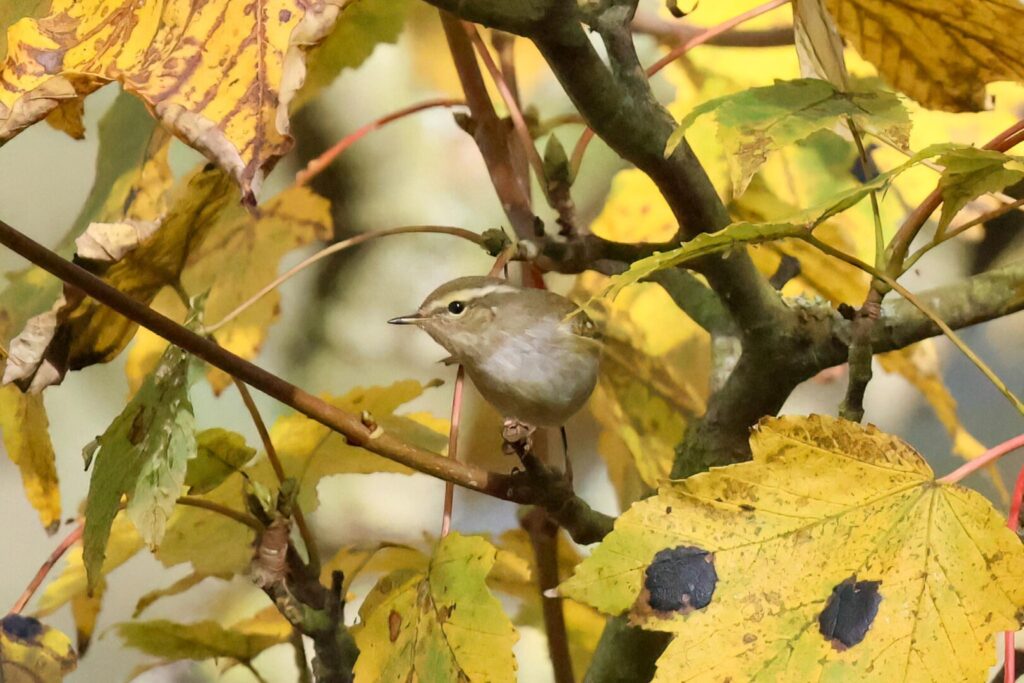
When we got to the west end of the pines, there were several people sitting scanning the sycamores. There were a couple of Yellow-browed Warblers here and as we stood and watched we finally got some better views. We could see their well marked yellowish supercilia and pale wing bars. Several Goldcrests and Chaffinches were feeding in the trees here too.
The Eastern Lesser Whitethroat was still here too and showed well, feeding up in the sycamores. A strikingly brown-backed individual, it would be interesting to know where it came from. The more regularly occurring Eastern races blythi (known as Siberian Lesser Whitethroat) and halimodendri (Central Asian) are not currently separable without a DNA sample!
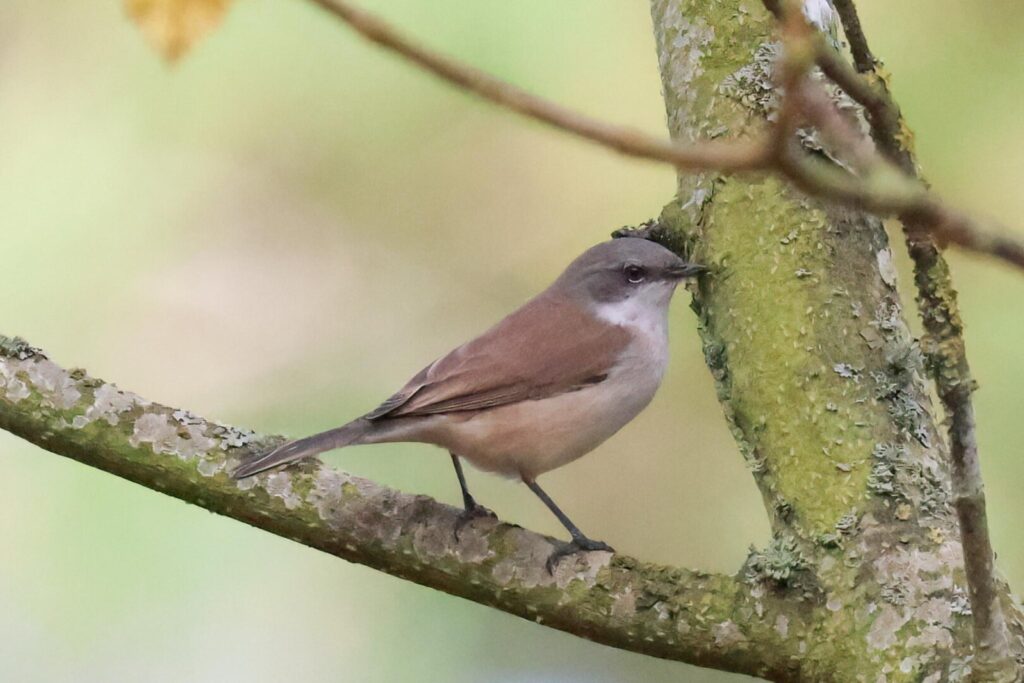
As we walked back along the track, we could hear Pink-footed Geese flying in to the grazing marshes. We had another quick look from Joe Jordan Hide but couldn’t find anything with them. There were more out on the grass further east, but nothing with them either. It would only be in the evening that we found out why. Having spent a couple of hours in Norfolk on Wednesday, the two Snow Geese had seemingly flown straight back to Lincolnshire! Possibly a lack of sugar beet to feed on here.

We made our way back to Lady Anne’s Drive and stopped for lunch on the picnic tables by The Lookout. A succession of Jays were still flying in and out from the pines.
After lunch, we drove west. At Burnham Norton, we noticed at least ten Cattle Egrets with the cows right next to the road. We pulled up for a quick look, although we had gone past the layby and there was nowhere to stop here. It has been a great year for Cattle Egrets here in Norfolk, the colonisation seems finally to have reached critical mass, although it will be interesting to see what happens over the winter, when most of the cattle are taken inside.
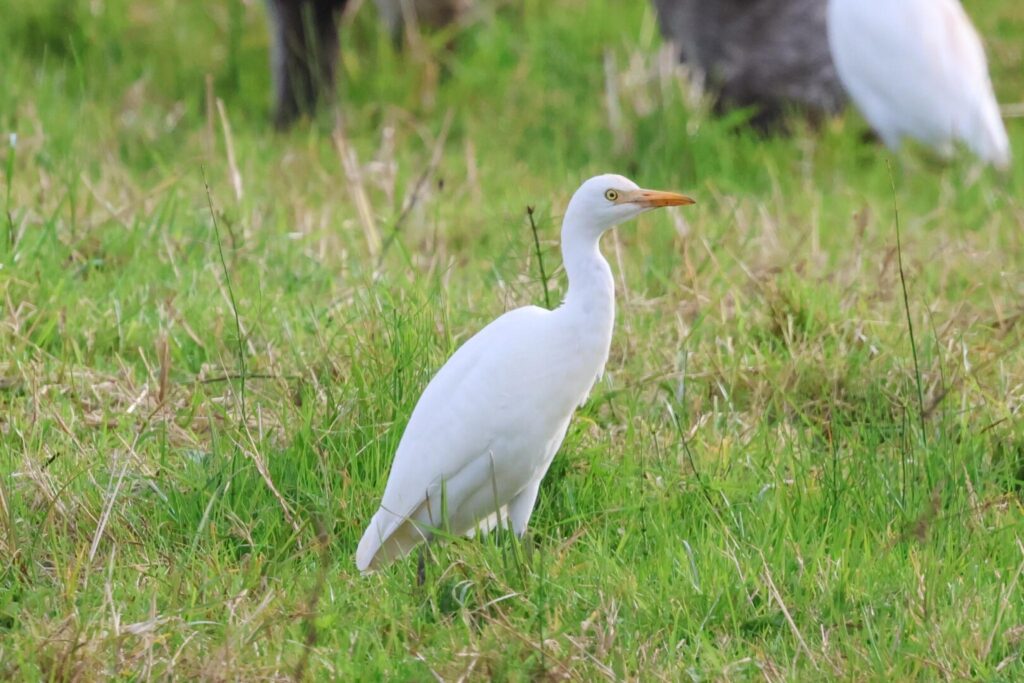
Our destination for the remainder of the afternoon was Holme Dunes. When we got to the Firs, we found lots of emergency vehicles in the car park. After checking in at the Visitor Centre, we walked up through the pines to look at the beach just as a large explosion went off in the dunes to the west. The bomb disposal squad were blowing up a couple of unexploded bombs which had been found on the edge of the beach. Large parts of the coast here were used for military training during the war and devices do still turn up from time to time.
Despite the disturbance, there were still a few birds out on the sand – Brent Geese, both Bar-tailed and Black-tailed Godwits side by side for comparison, Grey Plovers. We found a small group of Knot bathing in a pool with a group of Oystercatchers away to the east. The tide was already starting to come in, and more waders were flying past, off to Thornham to roost.
We couldn’t walk along the coast path, as it was closed off due to the unexploded bombs, so we cut back in to dunes. It was distinctly quiet as we walked along the paths to the Forestry. As we got there, we flushed a couple of Song Thrushes out of the bushes which were probably continental migrants. There were a few Blackbirds, Robins and Blue Tits, and we had a brief glimpse of a Blackcap, but it didn’t come back out. Two Pintail flew over.

When the second explosion went off, a Short-eared Owl flew up out of the dunes just beyond the coast path. Presumably it had been disturbed by the load bang. It flew up and down in front of us a couple of times, before dropping back down over the path out of view. A nice bonus, and possibly a fresh arrival from the continent.
As we walked back through the dunes, we found a couple of Stonechats now, which perched up obligingly.
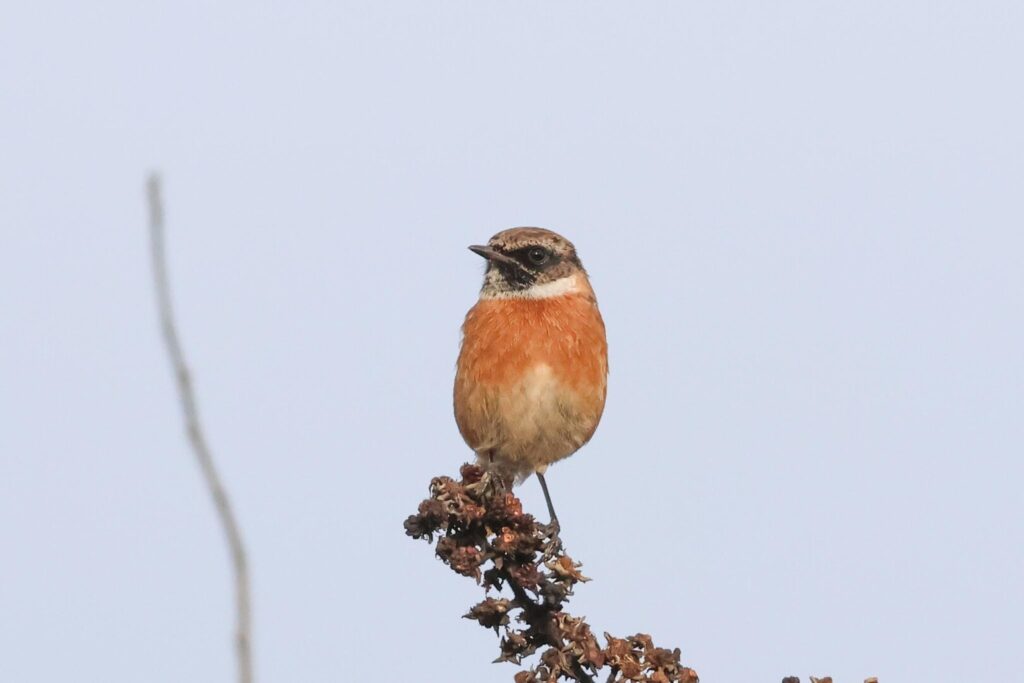
We cut across to the access track and took the path down to the hides. We decided to start in the furthest, and when we arrived we found several people already in there. One of the Jack Snipe was feeding on the edge of the rushes over the far side of the water. When it disappeared in, a Common Snipe then came out next to it.
There was a second Jack Snipe right in front of the hide, but it was tricky to see at first. It was feeding on the mud on the near side of the water, creeping very slowly through the grass. As it came out into a slightly more open area of vegetation we had some fantastic close views now, just a few metres from us. We could see the golden stripes on its back and the distinctive head pattern, lacking the central crown stripe of the Common Snipe. It was doing its distinctive bobbing on and off too.
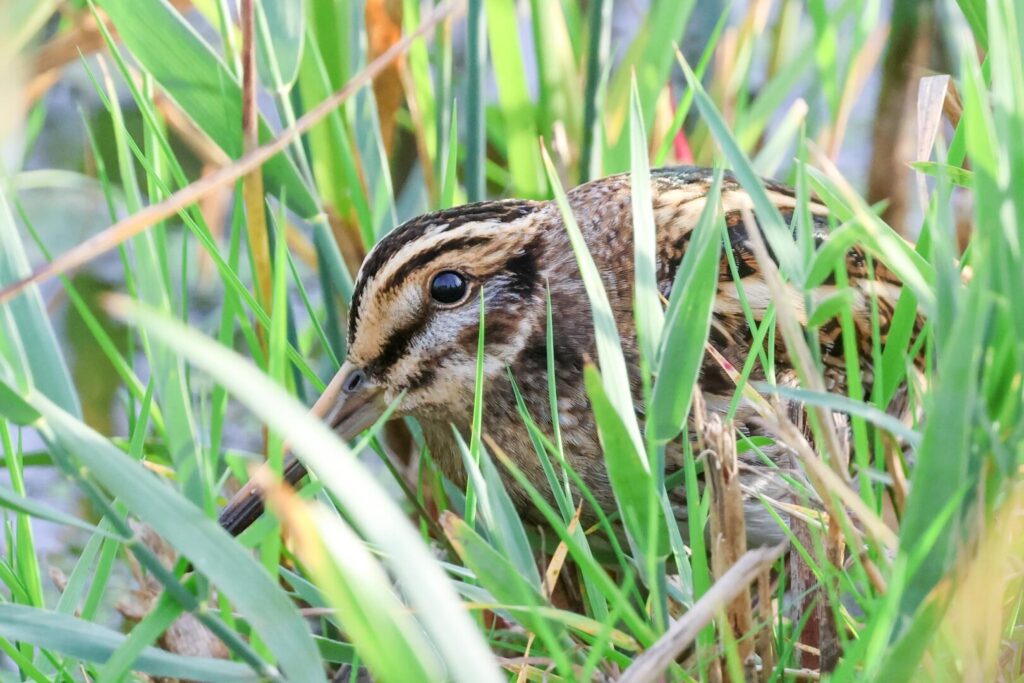
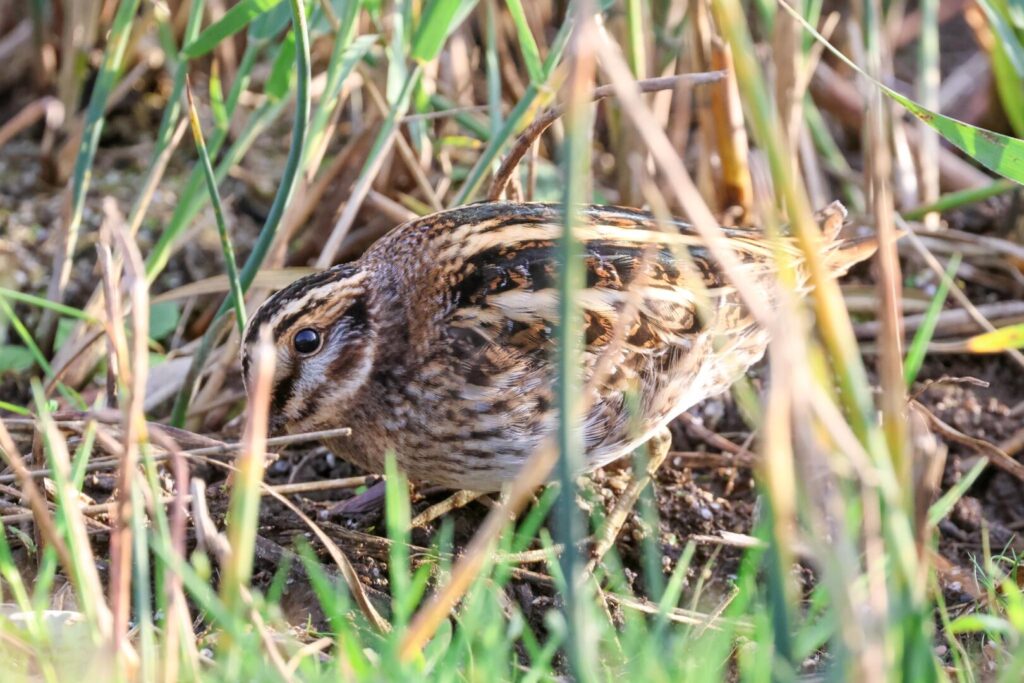
Having enjoyed point-black views of the Jack Snipe, unfortunately we were out of time now. We had to tear ourselves away in order to get back to Hindolveston in time for dinner. It had been an exciting first day – hopefully more tomorrow.
If you enjoyed reading about what we got up to and would like to join us on one of our forthcoming tours, you can see what we have planned on our Tours page here. We will be adding dates for 2025 Autumn Migration tours shortly. Please contact us for details.
















